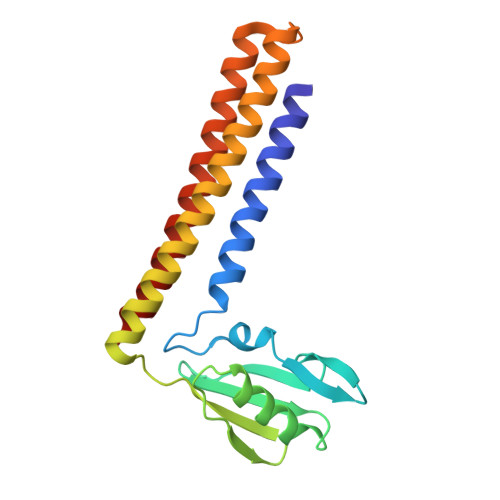Structure and binding mode of a ribosome recycling factor (RRF) from mesophilic bacterium
Nakano, H., Yoshida, T., Uchiyama, S., Kawachi, M., Matsuo, H., Kato, T., Ohshima, A., Yamaichi, Y., Honda, T., Kato, H., Yamagata, Y., Ohkubo, T., Kobayashi, Y.(2003) J Biological Chem 278: 3427-3436
- PubMed: 12411440
- DOI: https://doi.org/10.1074/jbc.M208098200
- Primary Citation of Related Structures:
1IS1 - PubMed Abstract:
X-ray and NMR analyses on ribosome recycling factors (RRFs) from thermophilic bacteria showed that they display a tRNA-like L-shaped conformation consisting of two domains. Since then, it has been accepted that domain I, consisting of a three-helix bundle, corresponds to the anticodon arm of tRNA and domain II and a beta/alpha/beta sandwich structure, corresponds to the acceptor arm. In this study, we obtained a RRF from a mesophilic bacterium, Vibrio parahaemolyticus, by gene cloning and carried out an x-ray analysis on it at 2.2 A resolution. This RRF was shown to be active in an in vitro assay system using Escherichia coli polysomes and elongation factor G (EF-G). In contrast, the above-mentioned RRFs from thermophilic bacteria were inactive in such a system. Analysis of the relative orientations between the two domains in the structures of various RRFs, including this RRF from mesophilic bacterium, revealed that domain II rotates about the long axis of the helix bundle of domain I. To elucidate the ribosome binding site of RRF, the peptide fragment (RRF-DI) corresponding to domain I of RRF was expressed and characterized. RRF-DI is bound to 70 S ribosome and the 50 S subunit with an affinity similar to that of wild-type RRF. But it does not bind to the 30 S subunit. These findings caused us to reinvestigate the concept of the mimicry of RRF to tRNA and to propose a new model where domain I corresponds to the acceptor arm of tRNA and domain II corresponds to the anticodon arm. This is just the reverse of a model that is now widely accepted. However, the new model is in better agreement with published biological findings.
Organizational Affiliation:
Graduate School of Pharmaceutical Sciences, Osaka University, 1-6 Yamadaoka, Suita, Osaka 565-0871, Japan.
















